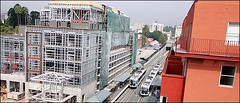Trading the Car for the Train
 J. Emilio Flores for The New York Times. An apartment complex during construction next to the Pasadena Metro Gold line.
J. Emilio Flores for The New York Times. An apartment complex during construction next to the Pasadena Metro Gold line. Last night at the ANC6C Planning and Zoning Committee people were demanding one-for-one parking at a site within 200 feet of the New York Avenue subway station. It's not quite as close to the subway tracks as the development pictured above, but it's pretty close.
In "Trading the Car for the Train," the New York Times reports that some people are making smarter decisions about the residential-transportation nexus, even if it isn't being reflected at the level of citizen planning participation... From the article:
Los Angeles may be the car capital of America, but a few Angelenos, it seems, are beginning to consider leaving their cars at home. Frustration with ever worsening traffic is stimulating new interest in denser, more urban patterns of development, a trend reflected by new mixed-use complexes near - or right on top of - transit stations.
One such development is Del Mar Station, with 347 mostly market-rate apartments distributed among four buildings, each in a different architectural style. Situated two blocks from Old Pasadena, this suburb's picturesque 19th-century business district, it is bisected by the tracks for the new Gold Line light-rail line, which also run directly underneath some of the apartments. The line carries commuters from the northeastern suburbs to downtown Los Angeles....
In suburban communities like Pasadena, residents often fear that denser development will increase traffic. "People make a fundamental mistake," Mr. Polyzoides said. "They see them as purveyors of gridlock." But instead, he said, people who live near stores will more likely do their errands on foot, thereby reducing traffic.
_____
A problem in cities, except perhaps for NYC, is that most of the "new" people that live in cities moved from the suburbs, and they bring their suburban planning and development paradigm with them when they move to the city. This is a real problem in the intermediate term, because this is a car-centric paradigm. Traffic is in fact increasing during peak hours in the core. As long as getting around by car is seen as the first, unthinking, choice, it will get worse. People have to challenge their cognitive schemas in order for this to change.
Another way to challenge cognitive schemas is to begin naming the subsidies and privileges that too many car owners treat as rights. And the subsidies have to be changed. For example:
- people who own big cars (SUVs) should have to pay a much higher price for a residential parking permit;
- parking permit fees should be increased across the board;
- free parking privileges in government facilities need to be eliminated;
- Congress needs to stop providing free parking privileges;
- transportation demand management plans should be required for new buildings (and many old ones including churches and businesses that receive a great number of deliveries);
Etc.
Click here to read the first chapter of Donald Shoup's book, The High Cost of Free Parking.
Clearly, this book needs to be one of the books chosen for the reading group.



1 Comments:
Hello. Kinda bored,, but looking for information on stocks. Informative blog, good info. Maybe visit my site if you're looking for stocks related material stocks. Have a good day.
Post a Comment
<< Home